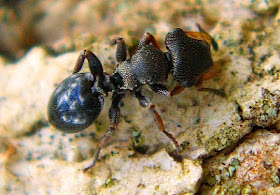The Mirror turtle ant (Cephalotes specularis) – an insect recently discovered in Brazil by entomologist Dr Scott Powell of the Columbian College of Arts and Sciences and his Brazilian colleagues – is the first-known species of ant to use visual mimicry to parasitize another ant species, according to a paper published in the October 2014 issue of the journal American Naturalist.
Dr Powell first discovered the mirror turtle ant while conducting fieldwork in Brazil.
He had climbed up into a tree to observe the thousands of hyper-aggressive host ants on their search for food, when he noticed that one thing wasn’t quite like the others.
“The mirror turtle ant nests just inches away from the well-guarded enemy enclave.”
“The host ants, Crematogaster ampla, travel by the thousands on a busy highway system, dropping chemical messages to their fellow workers along the way.”
“During rush hour, the mirror turtle ants, also colored black, dive out of their nest and rapidly merge into the high-speed traffic.”
“Once inside the host’s foraging network, the mirror turtle ants disguise themselves among the enemy workers by mirroring their unique body movements.”
“The impostors go largely unnoticed as they quickly weave through traffic lanes and dodge the host ants.”
“This mimicking behavior allows the parasitic ants to successfully locate and exploit the host’s food resources.”
In spy terms, this new form of social parasitism allows mirror turtle ants to steal food from an enemy.
“I did a true double-take when I first saw this new species. As I turned away, after seeing what appeared to be large numbers of host foragers, I noticed that a couple of the ants I had just laid eyes on were not quite like the others. Turning back around, I managed to re-find the few peculiar ants in the masses of host ants, and everything followed from there,” Dr Powell explained.
He and his colleagues conducted additional experiments to better characterize the different components of the parasite-host interaction of Cephalotes specularis and Crematogaster ampla.
They watched as the mirror turtle ants raised their backsides in the air, imitating the distinctive posture of host ants.
They also observed the parasitic ants’ keen capacity to ‘eavesdrop’ on the host ants’ pheromone-based foraging trails.
The mirror turtle ants are so skilled at this, in fact, that they are better at following the chemical trails of the host ant than those of their own workers.
The study also revealed that mirror turtle ants were embedded within a whopping 89 percent of host territories.
Dr Powell, who is the lead author of the paper on the team’s findings, said: “beyond the fascinating biology of this new ant, we appear to have a rare window into the early stages of the evolution of social parasitism, before the parasite has lost much of its free-living biology. This promises to help us better understand the general pressures that tip a species towards a parasitic lifestyle.”
Source: Here



No comments:
Post a Comment